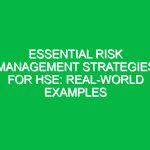Introduction
In today’s dynamic work Environment, the importance of effective risk management steps process within the Health, Safety, and Environment (HSE) domain cannot be overstated. Organizations across various industries face a multitude of risks that can compromise employee Safety, environmental integrity, and overall operational effectiveness. The risk management steps process serves as a structured approach to identifying, assessing, and mitigating these risks, ensuring a safer workplace and compliance with regulatory Standards. In this article, we will explore the essential steps involved in the risk management process and their relevance in enhancing HSE Safety.
Understanding the Risk Management Steps Process
The risk management steps process is a systematic approach that comprises several key stages, each of which plays a crucial role in managing risks effectively. These steps include:
- Risk Identification
- Risk Assessment
- Risk Control
- Risk Monitoring and Review
- Communication and Consultation
Understanding each step in detail can empower organizations to address potential Hazards proactively and cultivate a culture of safety.
1. Risk Identification
The first step in the risk management steps process is risk identification. This involves recognizing potential Hazards that could negatively impact health, safety, or the environment. Various techniques can be employed for effective risk identification, including:
- Site Inspections: Regular site inspections help in identifying physical hazards such as unsafe machinery or environmental risks.
- Employee Input: Engaging employees in discussions about their experiences and observations can uncover risks that management may overlook.
- Historical Data Analysis: Reviewing past incidents and accidents can provide insights into recurring issues that need to be addressed.
- Industry Standards and Guidelines: Adhering to established HSE standards can help in identifying common risks associated with specific industries.
For instance, consider a construction site where workers have reported frequent near-misses due to unmarked hazards. By involving employees in risk identification, management can better understand these dangers and take action to mitigate them.
2. Risk Assessment
Once risks have been identified, the next step is risk assessment. This entails evaluating the likelihood and potential impact of each risk. Organizations can utilize qualitative and quantitative methods for this assessment:
- Qualitative Assessment: This method involves categorizing risks based on their severity and likelihood of occurrence, often using a risk matrix.
- Quantitative Assessment: This approach assigns numerical values to risks, such as calculating potential financial losses or injury rates.
By systematically assessing risks, organizations can prioritize them based on their severity, allowing for more focused resource allocation. For example, a manufacturing facility may find that chemical spills pose a higher risk than minor equipment malfunctions, prompting them to implement stringent Safety Measures around hazardous materials.
3. Risk Control
After assessing the risks, the next step in the risk management steps process is to implement Control Measures. This involves determining how to minimize or eliminate identified risks. Control measures can be categorized into three primary types:
- Elimination: Removing the hazard entirely, such as substituting a harmful chemical with a safer alternative.
- Engineering Controls: Implementing physical changes to reduce exposure, such as installing ventilation systems or safety barriers.
- Administrative Controls: Establishing policies and Procedures, including Training programs or safety protocols, to guide employee behavior.
An illustrative example can be taken from the oil and gas industry, where companies have adopted advanced engineering controls to manage risks associated with drilling operations, significantly reducing the chance of accidents.
4. Risk Monitoring and Review
Risk management is not a one-time effort; it requires continuous monitoring and review. This step involves regularly evaluating the effectiveness of Control Measures and making necessary adjustments. Organizations should consider:
- Regular Audits: Conducting audits to verify compliance with safety protocols and identify areas for improvement.
- Incident Reporting: Encouraging a culture of reporting near-misses and incidents to gather data for analysis.
- Feedback Mechanisms: Establishing channels for employees to provide feedback on safety practices and suggest improvements.
For example, after implementing new Safety Measures, a manufacturing plant may conduct follow-up audits to assess their effectiveness, ensuring that the changes have positively impacted Workplace Safety.
5. Communication and Consultation
Effective communication and consultation are vital components of the risk management steps process. Engaging employees at all levels fosters a shared understanding of risks and safety practices. Organizations should implement:
- Training Programs: Regular training ensures that employees are aware of potential hazards and know how to respond effectively.
- Safety Meetings: Holding regular meetings to discuss safety issues encourages openness and collaboration.
- Clear Reporting Channels: Establishing accessible channels for reporting hazards or safety concerns empowers employees to take an active role in risk management.
Consider a healthcare facility where staff members are encouraged to participate in safety committees. Such engagement leads to improved communication about potential risks and enhances the overall safety culture.
Regulations and Standards Impacting Risk Management
The risk management steps process is heavily influenced by various Regulations and industry standards that govern HSE practices. Compliance with these regulations is not just a legal obligation; it also reinforces the commitment to safety and environmental responsibility. Some key regulations include:
- Occupational Safety and Health Administration (OSHA): osha sets forth regulations that require employers to provide a safe work environment and establish protocols for Hazard Communication.
- Environmental Protection Agency (EPA): The EPA regulates environmental risks, compelling organizations to manage waste and emissions effectively.
- ISO 45001: This international standard provides a framework for Occupational Health and safety management systems, guiding organizations in risk management practices.
Organizations that align their risk management steps process with these regulations not only enhance safety but also improve their reputation and operational efficiency.
Conclusion
In conclusion, the risk management steps process is essential for promoting health, safety, and environmental Sustainability in any organization. By systematically identifying, assessing, controlling, and monitoring risks, organizations can create a safer workplace and comply with legal requirements. The integration of effective communication and consultation further solidifies a culture of safety, ensuring that every employee is actively engaged in the process.
As industries continue to evolve, the need for robust risk management strategies will only grow. By embracing these essential steps, organizations can not only protect their workforce and the environment but also enhance their overall operational resilience. It’s time to take action—evaluate your current risk management practices and consider how they can be improved to foster a safer and more sustainable future.


